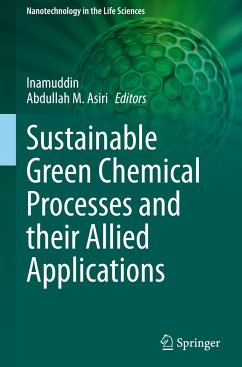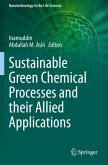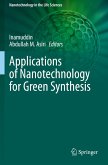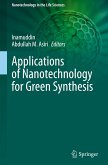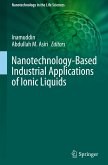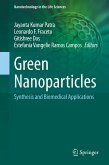Sustainable Green Chemical Processes and their Allied Applications
Herausgegeben:Inamuddin; Asiri, Abdullah
Sustainable Green Chemical Processes and their Allied Applications
Herausgegeben:Inamuddin; Asiri, Abdullah
- Gebundenes Buch
- Merkliste
- Auf die Merkliste
- Bewerten Bewerten
- Teilen
- Produkt teilen
- Produkterinnerung
- Produkterinnerung
Urbanization, industrialization, and unethical agricultural practices have considerably negative effects on the environment, flora, fauna, and the health and safety of humanity. Over the last decade, green chemistry research has focused on discovering and utilizing safer, more environmentally friendly processes to synthesize products like organic compounds, inorganic compounds, medicines, proteins, enzymes, and food supplements. These green processes exist in other interdisciplinary fields of science and technology, like chemistry, physics, biology, and biotechnology, Still the majority of…mehr
Andere Kunden interessierten sich auch für
![Sustainable Green Chemical Processes and their Allied Applications Sustainable Green Chemical Processes and their Allied Applications]() Sustainable Green Chemical Processes and their Allied Applications137,99 €
Sustainable Green Chemical Processes and their Allied Applications137,99 €![Applications of Nanotechnology for Green Synthesis Applications of Nanotechnology for Green Synthesis]() Applications of Nanotechnology for Green Synthesis145,99 €
Applications of Nanotechnology for Green Synthesis145,99 €![Applications of Nanotechnology for Green Synthesis Applications of Nanotechnology for Green Synthesis]() Applications of Nanotechnology for Green Synthesis145,99 €
Applications of Nanotechnology for Green Synthesis145,99 €![Nanotechnology-Based Industrial Applications of Ionic Liquids Nanotechnology-Based Industrial Applications of Ionic Liquids]() Nanotechnology-Based Industrial Applications of Ionic Liquids137,99 €
Nanotechnology-Based Industrial Applications of Ionic Liquids137,99 €![Nanotechnology-Based Industrial Applications of Ionic Liquids Nanotechnology-Based Industrial Applications of Ionic Liquids]() Nanotechnology-Based Industrial Applications of Ionic Liquids137,99 €
Nanotechnology-Based Industrial Applications of Ionic Liquids137,99 €![Green Nanoparticles Green Nanoparticles]() Green Nanoparticles225,99 €
Green Nanoparticles225,99 €![Green Nanoparticles Green Nanoparticles]() Green Nanoparticles225,99 €
Green Nanoparticles225,99 €-
-
-
Urbanization, industrialization, and unethical agricultural practices have considerably negative effects on the environment, flora, fauna, and the health and safety of humanity. Over the last decade, green chemistry research has focused on discovering and utilizing safer, more environmentally friendly processes to synthesize products like organic compounds, inorganic compounds, medicines, proteins, enzymes, and food supplements. These green processes exist in other interdisciplinary fields of science and technology, like chemistry, physics, biology, and biotechnology, Still the majority of processes in these fields use and generate toxic raw materials, resulting in techniques and byproducts which damage the environment. Green chemistry principles, alternatively, consider preventing waste generation altogether, the atom economy, using less toxic raw materials and solvents, and opting for reducing environmentally damaging byproducts through energy efficiency.
Green chemistry is, therefore, the most important field relating to the sustainable development of resources without harmfully impacting the environment. This book provides in-depth research on the use of green chemistry principles for a number of applications.
Green chemistry is, therefore, the most important field relating to the sustainable development of resources without harmfully impacting the environment. This book provides in-depth research on the use of green chemistry principles for a number of applications.
Produktdetails
- Produktdetails
- Nanotechnology in the Life Sciences
- Verlag: Springer / Springer International Publishing / Springer, Berlin
- Artikelnr. des Verlages: 978-3-030-42283-7
- 1st edition 2020
- Seitenzahl: 620
- Erscheinungstermin: 31. Mai 2020
- Englisch
- Abmessung: 241mm x 160mm x 39mm
- Gewicht: 1087g
- ISBN-13: 9783030422837
- ISBN-10: 3030422836
- Artikelnr.: 58563894
- Herstellerkennzeichnung
- Books on Demand GmbH
- In de Tarpen 42
- 22848 Norderstedt
- info@bod.de
- 040 53433511
- Nanotechnology in the Life Sciences
- Verlag: Springer / Springer International Publishing / Springer, Berlin
- Artikelnr. des Verlages: 978-3-030-42283-7
- 1st edition 2020
- Seitenzahl: 620
- Erscheinungstermin: 31. Mai 2020
- Englisch
- Abmessung: 241mm x 160mm x 39mm
- Gewicht: 1087g
- ISBN-13: 9783030422837
- ISBN-10: 3030422836
- Artikelnr.: 58563894
- Herstellerkennzeichnung
- Books on Demand GmbH
- In de Tarpen 42
- 22848 Norderstedt
- info@bod.de
- 040 53433511
Dr. Inamuddin is currently working as Assistant Professor in the Chemistry Department, Faculty of Science, King Abdulaziz University, Jeddah, Saudi Arabia. He is a permanent faculty member (Assistant Professor) at the Department of Applied Chemistry, Aligarh Muslim University, Aligarh, India. He obtained Master of Science degree in Organic Chemistry from Chaudhary Charan Singh (CCS) University, Meerut, India, in 2002. He received his Master of Philosophy and Doctor of Philosophy degrees in Applied Chemistry from Aligarh Muslim University (AMU), India, in 2004 and 2007, respectively. He has extensive research experience in multidisciplinary fields of Analytical Chemistry, Materials Chemistry, and Electrochemistry and, more specifically, Renewable Energy and Environment. He has worked on different research projects as project fellow and senior research fellow funded by University Grants Commission (UGC), Government of India, and Council of Scientific and IndustrialResearch (CSIR), Government of India. He has received Fast Track Young Scientist Award from the Department of Science and Technology, India, to work in the area of bending actuators and artificial muscles. He has completed four major research projects sanctioned by University Grant Commission, Department of Science and Technology, Council of Scientific and Industrial Research, and Council of Science and Technology, India. He has published 152 research articles in international journals of repute and eighteen book chapters in knowledge-based book editions published by renowned international publishers. He has published 67 edited books with Springer (U.K.), Elsevier, Nova Science Publishers, Inc. (U.S.A.), CRC Press Taylor & Francis Asia Pacific, Trans Tech Publications Ltd. (Switzerland), IntechOpen Limited (U.K.), and Materials Research Forum LLC (U.S.A). He is a member of various journals' editorial boards. He is also serving as Associate Editor for journals (Environmental Chemistry Letter, Applied Water Science and Euro-Mediterranean Journal for Environmental Integration, Springer-Nature), Frontiers Section Editor (Current Analytical Chemistry, Bentham Science Publishers), Editorial Board Member (Scientific Reports-Nature), Editor (Eurasian Journal of Analytical Chemistry), and Review Editor (Frontiers in Chemistry, Frontiers, U.K.) He is also guest-editing various special thematic special issues to the journals of Elsevier, Bentham Science Publishers, and John Wiley & Sons, Inc. He has attended as well as chaired sessions in various international and national conferences. He has worked as a Postdoctoral Fellow, leading a research team at the Creative Research Initiative Center for Bio-Artificial Muscle, Hanyang University, South Korea, in the field of renewable energy, especially biofuel cells. He has also worked as a Postdoctoral Fellow at the Center of Research Excellence in Renewable Energy, King Fahd University of Petroleum and Minerals, Saudi Arabia,in the field of polymer electrolyte membrane fuel cells and computational fluid dynamics of polymer electrolyte membrane fuel cells. He is a life member of the Journal of the Indian Chemical Society. His research interest includes ion exchange materials, a sensor for heavy metal ions, biofuel cells, supercapacitors and bending actuators. Prof. Abdullah M. Asiri is the Head of the Chemistry Department at King Abdulaziz University since October 2009 and he is the founder and the Director of the Center of Excellence for Advanced Materials Research (CEAMR) since 2010 till date. He is the Professor of Organic Photochemistry. He graduated from King Abdulaziz University (KAU) with B.Sc. in Chemistry in 1990 and a Ph.D. from University of Wales, College of Cardiff, U.K. in 1995. His research interest covers color chemistry, synthesis of novel photochromic and thermochromic systems, synthesis of novel coloring matters and dyeing of textiles, materials chemistry, nanochemistry andnanotechnology, polymers and plastics. Prof. Asiri is the principal supervisors of more than 20 M.Sc. and six Ph.D. theses. He is the main author of ten books of different chemistry disciplines. Prof. Asiri is the Editor-in-Chief of King Abdulaziz University Journal of Science. A major achievement of Prof. Asiri is the research of tribochromic compounds, a new class of compounds which change from slightly or colorless to deep colored when subjected to small pressure or when grind. This discovery was introduced to the scientific community as a new terminology published by International Union of Pure and Applied Chemistry (IUPAC) in 2000. This discovery was awarded a patent from European Patent office and from UK patent. Prof. Asiri involved in many committees at the KAU level and on the national level. He took a major role in the advanced materials committee working for King Abdulaziz City for Science and Technology (KACST) to identify the national plan for science and technology in 2007. Prof. Asiri played a major role in advancing the chemistry education and research in KAU. He has been awarded the best researchers from KAU for the past five years. He also awarded the Young Scientist Award from the Saudi Chemical Society in 2009 and also the first prize for the distinction in science from the Saudi Chemical Society in 2012. He also received a recognition certificate from the American Chemical Society (Gulf region Chapter) for the advancement of chemical science in the Kingdome. He received a Scopus certificate for the most publishing scientist in Saudi Arabia in chemistry in 2008. He is also a member of the editorial board of various journals of international repute. He is the Vice- President of Saudi Chemical Society (Western Province Branch). He holds four USA patents, more than one thousand publications in international journals, several book chapters and edited books.
Preface.- New approaches for renewable energy using metal electrocatalysts for lithium-O2 and zinc-air batteries.- Biodiesel production for the sustainable development of chemical industry.- Cellulose based green and sustainable energy.- Design of dithienopyrrole-based organic dyes for efficient dye-sensitized solar cells: Strategies and outcome.- Sonochemical production of hydrogen: A novel approach.- Impact of alcohol and its blends on engine performance.- Photovoltaic performance of bipyridine and dipyridophenazine-based ruthenium complexes in application of dye-sensitized solar cell sensitizers.- Compressed fluids for food by-products biorefinery.- Green and sustainable biomass processing for fuels and chemicals.- Enriching of carotenes by supercritical desorption of buriti oil (Mauritia flexuosa Mart.) from alumina adsorbent.- Utilization of bio waste in green chemistry.- The role of heterogeneous catalysts in cellulose conversion to platform chemicals and biofuels.- Potential of neem oil as source of biodiesel.- Sustainable photocatalyst for energy and environment application.- Implementation guidelines for modelling gasification processes in computational fluid dynamics: A tutorial overview approach.- Sustainable cellulose based absorbents for heavy metal remediation.- Recent trend in photo-catalytic water of azo dyes.- Hospital effluents treatment.- Solar photocatalytic treatment of tannery effluent.- Modification of natural fibers by graft copolymerization and their environmental applications.- Dye degradation for environmental remediation.- Exploring natural coagulant application in the treatment of water for safe drinking.- Sustainable technologies for the wastewater treatment generated by leather industry sector: Regulation and economic aspects.- Physical and biological techniques to remediate carcinogenic Cr(VI) from industrial effluents.- Separation of industrial effluents.- Application of polymers in purification of industrial wastewater.-Role of disinfectants in green chemistry.- Sonochemistry in green processes: modeling, experiments and technology.- Biosynthesis of silymarin through plant in-vitro cultures.- Chemistry for new frontiers in supramolecular theranostics.- Cellulose nanocrystal aerogels: Synthesis, functional properties, and applications.- Graphene oxide: An efficient, and recyclable nano catalyst for the synthesis of 2-substituted benzimidazoles from aldehydes and diamines at ambient temperature.- Green synthesis of TiO2 nanomaterials photocatalyst.- Green corrosion inhibitors for industrial cleaning processes.- Cellulose amphiphilic materials: Chemistry, process, and applications.- Oleogels and their applications.- Measuring corrosion abrasion in various solid-fluid systems.- Base-free conversion of aldose sugar to aldonic acid.- Treatment of dairy products with conversion of useful bio-products.- Green corrosion inhibitor for petroleum pipelines.- Impact and challenges of polymerization.- Index.
Preface.- New approaches for renewable energy using metal electrocatalysts for lithium-O2 and zinc-air batteries.- Biodiesel production for the sustainable development of chemical industry.- Cellulose based green and sustainable energy.- Design of dithienopyrrole-based organic dyes for efficient dye-sensitized solar cells: Strategies and outcome.- Sonochemical production of hydrogen: A novel approach.- Impact of alcohol and its blends on engine performance.- Photovoltaic performance of bipyridine and dipyridophenazine-based ruthenium complexes in application of dye-sensitized solar cell sensitizers.- Compressed fluids for food by-products biorefinery.- Green and sustainable biomass processing for fuels and chemicals.- Enriching of carotenes by supercritical desorption of buriti oil (Mauritia flexuosa Mart.) from alumina adsorbent.- Utilization of bio waste in green chemistry.- The role of heterogeneous catalysts in cellulose conversion to platform chemicals and biofuels.- Potential of neem oil as source of biodiesel.- Sustainable photocatalyst for energy and environment application.- Implementation guidelines for modelling gasification processes in computational fluid dynamics: A tutorial overview approach.- Sustainable cellulose based absorbents for heavy metal remediation.- Recent trend in photo-catalytic water of azo dyes.- Hospital effluents treatment.- Solar photocatalytic treatment of tannery effluent.- Modification of natural fibers by graft copolymerization and their environmental applications.- Dye degradation for environmental remediation.- Exploring natural coagulant application in the treatment of water for safe drinking.- Sustainable technologies for the wastewater treatment generated by leather industry sector: Regulation and economic aspects.- Physical and biological techniques to remediate carcinogenic Cr(VI) from industrial effluents.- Separation of industrial effluents.- Application of polymers in purification of industrial wastewater.-Role of disinfectants in green chemistry.- Sonochemistry in green processes: modeling, experiments and technology.- Biosynthesis of silymarin through plant in-vitro cultures.- Chemistry for new frontiers in supramolecular theranostics.- Cellulose nanocrystal aerogels: Synthesis, functional properties, and applications.- Graphene oxide: An efficient, and recyclable nano catalyst for the synthesis of 2-substituted benzimidazoles from aldehydes and diamines at ambient temperature.- Green synthesis of TiO2 nanomaterials photocatalyst.- Green corrosion inhibitors for industrial cleaning processes.- Cellulose amphiphilic materials: Chemistry, process, and applications.- Oleogels and their applications.- Measuring corrosion abrasion in various solid-fluid systems.- Base-free conversion of aldose sugar to aldonic acid.- Treatment of dairy products with conversion of useful bio-products.- Green corrosion inhibitor for petroleum pipelines.- Impact and challenges of polymerization.- Index.

